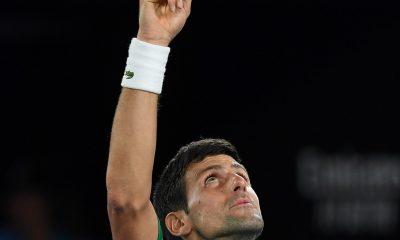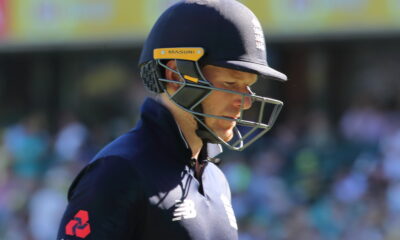Cricket
The Exponential Rise of T20 cricket

The Exponential Rise of T20 Cricket
The next instalment of the ICC T20 World Cup is set to commence later this year, despite fears over a large spike of COVID-19 cases in host country India. Though acting ICC chief executive Geoff Allardice has maintained that there are backup plans in place that can be triggered if the tournament cannot go ahead as first planned.
This tournament will be the seventh of its kind, after being postponed in 2020 and moved to October of 2021. India, Pakistan, England, Sri Lanka and more recently West Indies have lifted the trophy with Carlos Brathwaite hitting four consecutive sixes off Ben Stokes’ final over of the game to seal a dramatic win in 2016.
Though the T20 spectrum goes further than just world cup tournaments, with the format used in the majority of cricket’s most luxurious domestic competitions. Without T20 cricket there would perhaps be no IPL or BBL and even plans for The Hundred may have been laughed off. The rise of T20 cricket has transformed the sport into a completely different dimension though there are arguments that the format has created problems for the future of test cricket.
In this article, we take a look at the origins of T20 cricket, the dramatic growth it has experienced and how it affects other formats of the game, particularly test match cricket.
T20 Origins
In response to a fall in attendances and a lack of sponsorship revenue, English cricket was in need of a fresh and exciting domestic competition following the conclusion of the Benson & Hedges Cup. Discussions of a shortened format had begun in the late ’90s but became more prominent following the turn of the century. Then ECB marketing manager Stuart Robinson is widely credited with creating the T20 format which was pitched to county chairmen in 2001.
With chairmen voting in favour of the new format by 11-7, the Twenty20 Cup was implemented into English cricket with the first-ever T20 fixture taking place at the Rose Bowl between Hampshire Hawks and Sussex Sharks, with the hosts coming out on top. The number and demographic of crowds the tournament attracted was exactly what the ECB was looking for, the first T20 fixture held at Lord’s even saw a sellout crowd of 27,509 with families able to taste a new, thrilling perspective of domestic cricket. Surrey Lions triumphed over Warwickshire Bears on the inaugural finals day at Trent Bridge in what rounded off a successful competition.
T20 cricket was introduced to the international stage by England and New Zealand’s women’s teams, with the Black Caps winning by nine runs at Hove in 2004. Whilst the first men’s T20I fixture was contested between Australia and New Zealand at Eden Park, although it was a light-hearted affair to say the very least. Both teams took to the field in 1980s themed kit with Stephen Fleming’s side wearing a replica of New Zealand’s famous beige brigade, with players even donning fake moustaches and wigs as the teams took part in a “best retro look” competition between themselves, something which is unimaginable to picture these days. Umpire Billy Bowden even comically showed Glenn McGrath a red card after the seamer proceeded to recreate Trevor Chappell’s infamous underarm incident with the Black Caps needing an impossible 45 runs from one ball.
The IPL Explosion
Following the success of the Twenty20 Cup in England and the 2007 ICC World Twenty20, the world was awaiting a T20 league where big names would congregate for a festival of cricket, and where better to play host than India? Though the formation of the Indian Premier League has been largely put down to the little-known and now-defunct Indian Cricket League.
The ICL was a private cricket league not recognised by the BCCI. Indian Media group Zee Entertainment Enterprises financially backed the tournament in order to provide lucrative sporting content after missing out on the rights to broadcast all BCCI-sanctioned cricket matches in India. Although the competition can be deemed as slightly confusing, a six-team league played out the inaugural 2007 season with the top four teams qualifying for the semi-finals after each side had played each other once.
Chennai Superstars were crowned as winners, though only three months later an eight-team league competition was played with the addition of Lahore Badshahs and Chandigarh Lions, who were captained by the iconic Inzamam-ul-Haq. In addition to this, the 2008 season also featured a three-team tournament between ICL World, ICL Pakistan and ICL India labelled as a “world series” with the latter reigning triumphant. Not the easiest to understand, I must admit.
With almost an identical version of the competition commencing again in 2008 -with the Mumbai terrorist attacks putting a stop to the world series- there were benefits to the league becoming apparent. The IPL has become renowned for developing homegrown Indian talent with the likes of Ishan Kishan and Suryakumar Yadav starring in the recent T20I series against England. Though the ICL gave a first glimpse of how funding provided by a league can benefit regional players without having to rely on the BCCI. The revenue created from the league was then allowed to be spent on improving regional training facilities, without the input of the BCCI.
But obviously, the league didn’t last. As previously mentioned, the BCCI failed to recognise the ICL as a league and took a strict stance against those who opted to play in it by handing lengthy international bans to players, other national cricket boards also provided bans such as the BCB who lost a whole team to the ICL. The ICC stated they would not recognise the league due to the fact the BCCI didn’t, meaning partaking players even risked losing their registration with ICC, stopping them from being able to play any domestic cricket. With the eventual discontinuation of the league, amnesty was offered to players as the IPL came to the fore of world cricket.
With the danger of a large cohort of players joining the ICL, the BCCI opted to increase prize money for winners, runners-up and losing semi-finalists across all domestic tournaments, though this had little effect. The only way to put a stop to the ICL controversy was an inevitable one with the BCCI announcing the formation of the IPL which would first commence in 2008. Then BCCI vice-president Lalit Modi is accredited with creating the tournament’s structure, however, he argued that the creation of the competition was not a reaction to the rise of the ICL.
IPL auctions have become renowned for the extravagant bidding of cricket’s global talent in the past decade and it was Mahendra Singh Dhoni who proved to be the most expensive purchase from the 2008 auction, though Sachin Tendulkar, Sourav Ganguly, Rahul Dravid, Yuvraj Singh and Virender Sehwag were all listed as icon players who were not available through the auction. Brendan McCullum’s sumptuous 158* for Kolkata Knight Riders stole the show of the inaugural IPL fixture in what has turned out to be the birth of a sporting giant. Rajasthan Royals were crowned winners of the competition with Shane Watson awarded player of the tournament.
Since then, the IPL has boomed and is now a money making giant as well as a high-quality spectacle. With team’s possessing a strong core of support based on their regional locations, IPL attendances have proved a success in the same way the Twenty20 Cup crowds boosted English cricket. IPL 2019 attracted an average attendance of 25,700, more than European sports leagues such as Ligue 1 and Serie A.
The wealth of talent involved and India’s passion for the sport has also seen IPL viewership skyrocket, IPL viewership figures even trumped Premier League matches under the pay-per-view system in October 2020. Star India own television and digital rights to the IPL after paying $2.55 billion for a four year period from 2018-2022, worth $637.5 Million per season. Numbers that are unheard of in the world of cricket. The competition’s current sponsorship deal with Vivo is worth a mouthwatering $60 million per year. Despite a significant 22% unavoidable drop in brand value following COVID-19, the IPL maintained a worth $4.4 billion, though interestingly Rajasthan Royals are the only team to suffer a decrease in brand value since 2009.
Away from the financial perspective, the quality of cricket that the IPL produces is unrivalled by any other cricket league in the world. Mumbai Indians have won the competition a record five times under the captaincy of Rohit Sharma. Chennai Super Kings have tasted success on three occasions, Kolkata Knight Riders are two-time winners whilst Rajasthan Royals, Sunrisers Hyderabad and the discontinued Deccan Chargers have also reigned victorious.
T20’s Wider Effect on the Game
T20’s rise as a format has affected cricket as a whole in a variety of ways. Following on from the IPL, a whole host of T20 leagues have been formed with great success. The Big Bash League was created in 2011 and like the IPL, has attracted high-quality players alongside mass crowds to create an exciting tournament down under. The Caribbean Premier League, Pakistan Super league and Lankan Premier League are all competitions that are continuing to grow and attract bigger names with a greater impetus on white-ball cricket now than ever before.
The United Arab Emirates plays host to the T10 league which more often than not splits opinion, however, the facts are that the league is recognised and accepted by all governing bodies. As previously mentioned, there is a greater need for individuals to play a substantial volume of white-ball matches, with the aforementioned T2o World Cup in the not too distant future, whilst other players look to secure lucrative contracts with franchises if international cricket is not a possibility. But platforms such as the T10 league would not be presented to players without a viable format having succeeded previously, therefore T20 is providing more players with more opportunities to further develop and enhance their skills.
Another sporting downside to the COVID-19 pandemic was the postponement of the first edition of The Hundred. Again, The Hundred is a watered-down format of the game which has sparked debate amongst cricket fans. Whether the competition is a success or not is yet to be seen, though what is concrete is that the concept would have been laughed off if T20 was not its predecessor.
With the T20 Blast somewhat losing prestige, The Hundred is set to attract a different level of player to British shores, whilst grasping the attention of a younger generation of fans through an eye-catching marketing campaign and the availability of certain games on free-to-air television. If The Hundred reinvigorates excitement in domestic English cricket and provides the ECB with a timely financial boost, it will be classed as a success, and it would have never happened without T20 cricket. More evidence of how the format has helped cricket develop.
"The temptation to be part of it was too great to resist."
Sarah Taylor is BACK!
She will play in The Hundred this summer!
Find out more: https://t.co/mDyIkxs0Td#bbccricket pic.twitter.com/nSol6xRrt0
— Test Match Special (@bbctms) April 6, 2021
On the flip side, in the opinion of some, T20 cricket has had a detrimental effect on the longer form of the game. Test match cricket has a befitting name because, in essence, it tests mental strength and technical skill like no other format. Though some of those skills required in a test player’s profile have waned in recent years at the expense of white-ball cricket. Ricky Ponting has gone on record previously to state that, the mindset of younger players has changed to aid scoring runs in shorter formats as opposed to not giving away their wicket which is vital in whites. Perhaps suggesting that players of test match DNA are a dying breed, which would be a great shame.
There has been evidence of players struggling to transition between the different formats in the past too. Jason Roy’s inclusion in the Ashes 2019 squad after starring in England’s successful world cup victory, highlighted the contrast in skills and mentality between different forms of cricket. At his best, Roy is a batsman who possesses immense power and skill whilst with an aggressive mentality that suits his style, though the habits of playing white-ball cricket undeniably had an effect on his five test fixtures against Ireland and Australia.
The Surrey batsman appeared to lack the defensive discipline required against a potent Aussie attack, which culminated in a habit to attack deliveries that weren’t there to played and nicking off. Roy’s dismissals also showed that white-ball cricket doesn’t provide a solid defence needed in tests. On numerous occasions, he played at deliveries that could have been left or blocked as a result of not trusting his defensive ability.
Roy is not isolated in struggling to transition between formats, Jonny Bairstow’s test struggles can also be put down to his phenomenal ODI form in recent years. A batsman Sir Alastair Cook’s quality even struggled for form in tests as he looked to rectify his fifty-over game -particularly outside off stump- ahead of the world cup in 2015, though he was dropped just two months before the tournament. High-quality limited-overs players such as Yuvraj Singh, Lasith Malinga, Imran Tahir and Rohit Sharma -outside of India- have all struggled in the longer format despite having shown their ability in shorter formats.
Test match cricket is widely considered the pinnacle of the sport too, meaning that it should be every player’s dream to represent their country in that format. Though the rise of T20 and franchise competitions have seen some players opt for lucrative contracts over the honour of test cricket. This has been a significant issue for the Cricket West Indies whose selection policy has denied the opportunity for many of their big names to play international cricket. The policy requires eligible West Indies players to play in their homeland’s domestic competitions in order to be considered for international selection. Whilst some play in the CPL and are available for T20I’s, others have chosen to travel the world and pick up financially rewarding contracts in the process. The likes of Chris Gayle, Dwayne Bravo, Kieron Pollard and Sunil Narine are just some to have opted out of test cricket in favour of T20.
The conclusion
To summarise, T20 cricket has provided the sport with a much-needed injection of excitement and interest, whilst benefiting governing bodies with monetary boosts that have helped develop the sport. The format saw the creation of the IPL which is now one of sports most prestigious competitions despite forming amongst controversy. Although there have been signs for a while now that the shorter format of the game may hamper test cricket’s progression.
The development of players suited to white-ball cricket would be of detriment to test matches and disappointing to see. And the format has provided players with a debate between test cricket and franchise leagues which should not really exist. Hopefully, a balance between all formats can be struck to benefit cricket as a whole.
We hope you enjoyed the article ‘The exponential rise of T20 cricket.’ What are your opinions on T20 cricket? Let us know!
Read more on cricket here:
-

 News1 month ago
News1 month agoThe Best Male Tennis Players of All Time
-

 Uncategorised1 month ago
Uncategorised1 month agoWhat Dinosaur Has 500 Teeth?
-

 News1 month ago
News1 month agoThe Fastest Rugby Players Ever
-

 Football1 month ago
Football1 month agoThe Best Penalty Takers of All Time
-

 Football1 month ago
Football1 month ago10 of the most underrated footballers in the world right now
-

 Football1 month ago
Football1 month agoPlayers with the most goals in a Premier League season
-

 Football1 month ago
Football1 month agoWho is the Fastest Football Player in the World?
-

 Football1 month ago
Football1 month agoChelsea’s Possible Lineup For Next Season


















